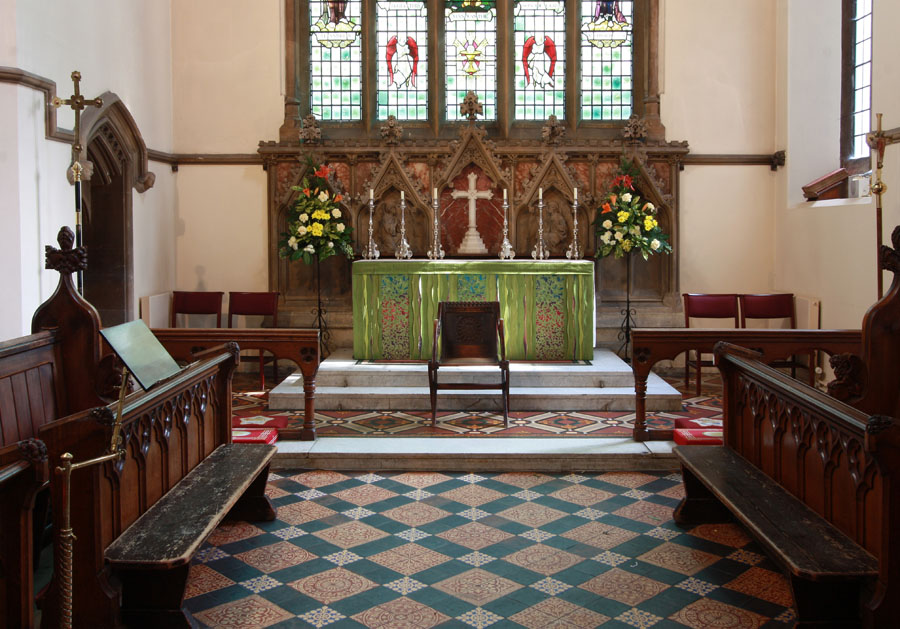Photographs by John Salmon. You may use these images without prior permission for any scholarly or educational purpose as long as you (1) credit John Salmon and (2) link your document to this URL in a web document or cite the Victorian Web in a print one. Click on the images to enlarge them.


Left: The south side of the church. This shows the south porch entry and south-west tower, facing Romford Market Place. Right: View of the north side of the church. Seen here are its varied roof levels, the clerestory windows, and the vestries that were added on later.
The Church of St Edward the Confessor, Romford, occupies the site of an early fifteenth-century chapel which was also dedicated to St Edward, who is said to have had local connections — but was anyway one of England's most popular saints at that time (see Farmer 138-39). The chapel in this historic market town had finally been demolished only in 1849. The original plan was to replace it with one designed by Edward Blore, at the other end of the market place. However, that scheme failed because of lack of funding. The present church, in the same spot as the old one, was designed by John Johnson and built in 1849-50 using Kentish ragstone with Bath stone dressings. Some of the materials are thought to have been recycled, both from the older chapel, and from recent demolition work on the Colonnade of Nash’s Quadrant in Regent Street (see "Present Church" and Cherry et al. 191). Soaring over the market place, the spire reaches 162' and makes a good landmark.
Interior

Looking east towards the chancel.
The church is spacious without being cavernous like some of the later Victorian edifices, with a wide clerestoried nave, a west gallery, north and south aisles, a chancel and south chapel. The aisle arcades have octagonal columns alternating with quatrefoil ones, all with lovely foliate capitals — Johnson excels in such richly detailed work. Pevsner may just have been referring to the exterior when he described the church as quite "showy," even "fussy" (Cherry et al. 62, 191) but perhaps he also had in mind the little sculpted faces at the points of the arcade spandrels, and the elaborate corbels at each side of the chancel arches, which also end with faces. But these are just what the medieval church-builders would have liked. The church's own website suggests that such pieces might in fact have come from the old chapel, but Johnson loved this sort of thing and is more likely to have designed them himself (see Part II for images and more discussion).

The Sanctuary.
Again, the carved details and finishings here are very fine, intricately worked like the window tracery and screens. The church is Grade II* listed, and this must be due in part to the three late sixteenth- and very early seventeenth-century alabaster monuments preserved and brought in from the old chapel (see Powell). But this Victorian craftsmanship too is worthy of recognition.


Left: The High Altar. Right: Looking across the Sanctuary into the South or Lady Chapel.
The stained glass here is a post-war replacement; the altar too is clearly modern (and equally striking), though the reredos seems to be original [Closer view of the altar and reredos].


Left: The South Aisle. Right: The South or Lady Chapel [Closer view of the Madonna and Child].

Looking towards the west end of the church.
Seen here are the fine timber roofs of the nave and aisles, the south porch opening to the left and the west gallery, with the organ (which was originally in the north aisle). The hammerbeam roof of the nave is complemented by the more simply structured beams of the lean-to aisles.
Related Material
- St Edward the Confessor, Romford, II: A Gallery of Details, Fixtures and Fittings
- [Stained glass windows:]Christ's Ministry
- The Transfiguration
- The Resurrection
- The Nativity
- The Ascension
References
Cherry, Bridget, Charles O'Brien and Nikolaus Pevsner. London: East. New Haven and London: Yale University Press, 2005.
Farmer, David. The Oxford Dictionary of Saints. 5th ed. rev. Oxford: Oxford University Press, 2011.
Powell, W. R., ed. "Romford: Religious History." In A History of the County of Essex, Volume 7. London, 1978. 82-91. British History Online. Web. 9 June 2015.
"Present Church." The Parish Church of St Edward the Confessor, Romford. Web. 9 June 2015.
Created 9 June 2015